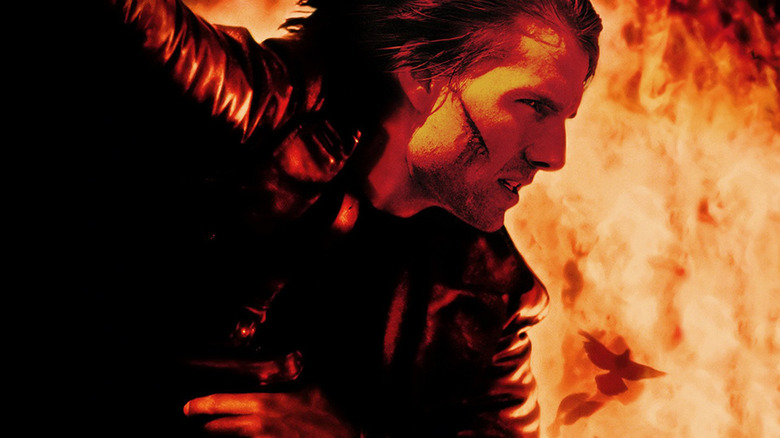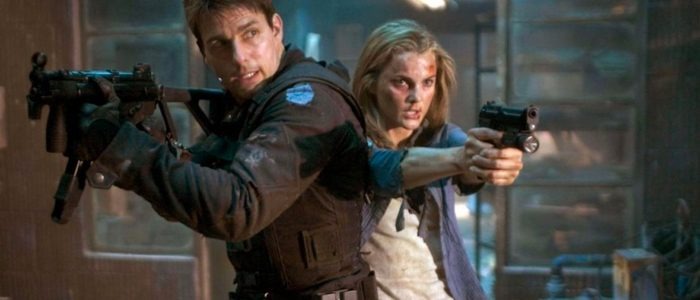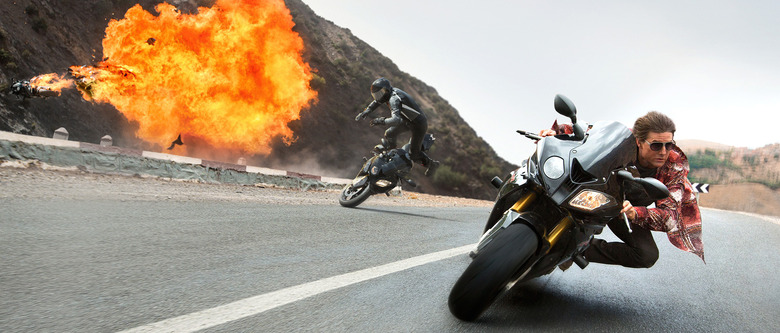What We Learned From Three Great 'Mission: Impossible' Audio Commentaries
What all goes into making a Mission: Impossible movie? According to the star and arguably the mastermind behind the film franchise, "fun." If there's one word Tom Cruise consistently uses to describe making these movies and all his death-defying stunts, it's fun. Cruise always sounds like he's having the time of his life making movies, but from the sound of it, he has an especially good time making Mission: Impossible movies.
We all know Tom Cruise is a great actor and movie star, but he's also a great producer. With each Mission: Impossible commentary, the directors share his notes and input, and they range from shots needed for a sequence, how to get across a piece of exposition, what Ethan would and would not do, and a whole lot more. He knows exactly what a Mission: Impossible movie needs to be. He has really shaped what a franchise is all about, with the help of countless fellow filmmakers he always makes sure to thank during the end credits.
Below, check out what we learned from the Mission: Impossible audio commentaries.
Mission: Impossible II (John Woo)
Why Listen: Of all three tracks on here, Woo's is the most technical and contains knowledge any fan of the filmmaker wants to hear. He goes into his standard process as much as the process of making a Mission: Impossible movie. Right after the first movie Cruise knew he wanted a new filmmaker for each sequel, so he was always encouraging Woo to ignore Brian De Palma's movie. The director wanted to make an action movie with "more charm, more passion, and more color," with Cruise suggesting shooting in Australia and emphasizing orange and red. Woo also lists off plenty of references — Notorious, To Catch a Thief, and How to Steal a Million — and chuckles talking about making his very first PG-13 movie. Mission: Impossible II's body count and violence were cut down considerably. Sometimes "one take" Woo is just happy watching the movie silently, but when he has something to say, it's of substance.What's Said: To the director behind Hard Boiled and The Killer, when Hunt and Nyah (Thandie Newton) share steamy glances as their cars spin angelically together it's as if they're "making love." The sequence and the rest of the film's action were inspired by one constant source of inspiration for Woo:
When I'm designing an action sequence I usually like listening to music. The music gives me a lot of inspiration for how to get the idea of the action. When I designed the car chase scene I was listening to "The Windmill of Your Smile," so I could get the mood and momentum. It all came from the song.
The race track sequence caused a lot of problems for Woo and the crew, with the weather changing constantly and a special lighting need for continuity. A lot of it was reshot, but again, Woo sought music while cutting the sequence:
I love slow motion, it's the beauty of action. It makes the shot look so much like a painting and poetry. When I'm making an action scene, I like to use different speeds and camera movements to get a shot. If I have three or four shots, one camera may be 120fps, the second camera maybe 60fps, third camera maybe 30fps, and the main camera on 24fps. After I get all the shot and different speed, I work it out in the cutting room. When I cut a scene, I like to base it on the music. I follow the rhythm and pace.
A Day on the Job: Woo sees actors like his children when he's working, and that even goes for the extras. He wants to make everyone look their best, but more than that, he wants to develop deep bonds with his actors. With that in mind, imagine Woo's horror as he watched one of his children hanging off a cliff at over 2,000 ft with no protection on the ground to save him:
Tom jumped several times and hanged off the cliff. It was pretty scary. The scary thing is, Tom wanted to do the whole stunt by himself. I was very scared, worried, and panicked. For the one shot of him jumping, I said the stunt double should do it, but Tom insisted he do it himself. We had a long argument about it because I tried to stop him. It didn't work. Tom said he likes the challenge, something he hadn't done before, and that he never liked cheating. He said it's easy to tell when it's a stunt-double, and not the actor, because of the body movement, timing, and performance never match. He didn't want to see that happen. I let him do it, and I was scared. At the meantime, I was scared of heights, so I stayed away from the cliff, like 20ft behind. When Tom did the jump, I couldn't bear to watch it. I kept closing my eyes, praying.
After Cruise made the jump, he yelled, "I'm fine, don't worry, I want to do it another time!" The actor completed the jump six or seven more times until they got the perfect shot. The most challenging sequence of Woo's career scared him, but he ended up admiring Cruise, who he calls "a man with no fear."
Trivia: Jon Woo hates the rehearsal process and instructing actors too much because he wants to be surprised, and he also dislikes the casting process because he doesn't like saying no to people.
Mission: Impossible III (J.J. Abrams and Tom Cruise)
Why Listen: Abrams' audio commentaries are always about as breezy and enjoyable as his movies. Like Cruise, his love for what he does for a living comes through during every scene and shot he's discussing. Now, there is a lot of talking about just what's happening on the screen, which is usually not what you want to hear from a commentary, but Abrams and Cruise do it with a giddiness that makes their discussion more endearing than repetitive. Their conversation moves fast, too, with the two sharing a lot of laughs and tidbits of info. Boy does Cruise laugh a lot in these tracks. It's rare to hear a movie star at his level sound like they're having a ball during a commentary. It's an entertaining track with Cruise showing nothing but love for the movie: "Did I miss the chocolate line? I love the chocolate line."What's Said: Something great about the Mission: Impossible movies is they don't always have to end big. Rogue Nation ends with a thrilling foot chase, while MI:III ends with a brutal hand-to-hand fight between adversaries. Mission: Impossible III's third act is intimate, not small, and also features a shouting match between two fantastic actors, Tom Cruise and the late Philip Seymour Hoffman, that's more exciting than a city in peril.
Here's Abrams and Cruise remembering the days with Ethan Hunt maybe at his lowest, captured and restrained:
Abrams: Maryann Brandon, who cut this part of it [where Hoffman is threatening to shoot his translator disguised as Julia], and Mary Jo [Markey] sort of split reels of the movie to cut. Maryann did a shorter version of the opening scene. It's not quite every moment, but it plays the crucial beats. How did you get this tear to happen?
Cruise: It just happened.Abrams: This shot here is something Alex Kurtzman and Bob Orci kept saying we needed, and they could not have been more right. To cut back to the wide, seeing him left alone in this room, and realizing he's not alone [and Billy Crudup's character is about to appear].... We didn't have the scene [written where Crudup reveals his motivation] until literally that morning. It's always a tricky scene when you get the ultimate explanation from a bad guy, but the fun of the movie to me is, the bad guy is so clearly established as Phil. It is a long speech, but having said that, I'm fascinated by his motivation, and just love his performance. There was a longer version of this scene we cut down.
Cruise had to hold up cue cards when Crudup needed them. Another scene that wasn't written until the day of shooting was when Ethan and Owen Davian first come face-to-face on the plane and Ethan goes berserk.
A Day on the Job: Hoffman makes every minute he appears in the film. The actor's screen time isn't big, but his presence is. Abrams and Cruise were in awe of his performance when he played Ethan Hunt disguised as Davies:
Abrams: He watched his performance. I mean, look at this [when he goes "thanks, thanks" and grabs Luther, smiling]. That's so you. He did that himself, and it was one of the greatest things I've ever seen. They're these two different guys.
Cruise: Phil watched how I moved. You can see what he's doing, now he's moving like Ethan. Look at Phil move [when he's swinging around as Ethan]. You have to appreciate the detail of his work, and how hard he worked to get that movement. He was a wrestler in High School, a very good athlete. I love Phil, look at him.Abrams: I love his performance shift. He's playing two people and makes it so easy. This is a motion control rig where Phil played both parts [in the bathroom].Trivia: The disposable camera that delivers the first mission was Steven Spielberg's idea.Bonus Trivia: The apartment in Eyes Wide Shut was Stanley Kubrick's old apartment in New York City.
Mission: Impossible - Rogue Nation (Christopher McQuarrie and Tom Cruise)
Why Listen: McQuarrie and Cruise waste no time breaking down the nuts and bolts of each scene. Everything one would want to know about the making of Mission: Impossible – Rogue Nation is found here. The duo's description of the stunning opera house sequence, for example, is packed with info showing the work required to pull it off. No stone ever goes unturned. It's also the first commentary where I've heard an actor suggesting a very specific pickup shot to a director; he knew it would add to a crucial moment for Ilsa. Cruise knows storytelling – especially effective visual storytelling. The actor and producer shows a great sense of what is cinematic and what is not, hence the 30-plus years of stardom and quality movies.What's Said: Whenever the IMF are on one of their globetrotting adventures, McQuarrie felt the need to bridge the gaps, but that wasn't always necessary. Thanks to some advice from Cruise, he realized audiences don't care how the characters get from point A to point B, as long as they knew what they were doing:
Having made four of these other movies, you had this incredible insight during periods of total insanity. Moments where the script just did not seem to hang together going from one scene to another, you'd just say with absolute confidence, "This is Mission: Impossible, man. You don't need to do that stuff. Just cut to the next scene. They're not going to worry about it." I'd think, "All right, we're going to be back reshooting this transition a month from now," but then you got there and realized you didn't need all that business.
A Day on the Job: The last sequence that production worked on was the underwater sequence. Five days before the premiere, some shots still needed tinkering, so McQuarrie and Cruise gave their final notes and didn't see the finished effects until the night of the premiere.
The co-writer and director explains how they planned the sequence:
I was given 10 day shoot all of the underwater stuff. The experience of Edge of Tomorrow had taught us how time-consuming underwater work is, so I was uniquely prepared having worked on that, working with Doug while they were shooting second-unit. I was then able to say, "If I have 10 days to shoot this sequence, the way it's currently designed, I would need a month to shoot it. I know I can get X number of shots a day." We decided very early on the best way to do it would be to shoot it in single takes. We designed it so we would only have to do two set ups a day, and the caveat being you would have to then have to hold your breath for an inordinate amount of time.
Trivia: McQuarrie originally imagined an 8-minute-long motorcycle chase, and after worrying it wouldn't be big enough, he realized the shorter version he shot was already too long.



